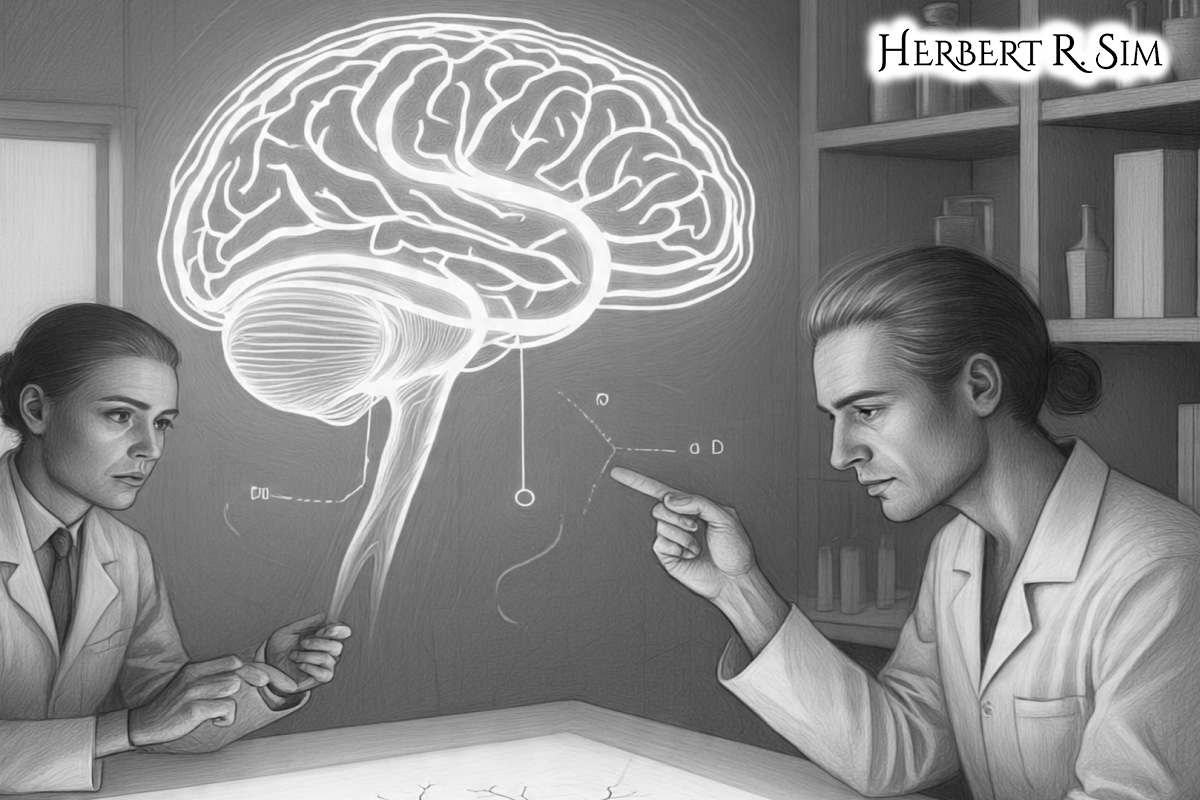
Above is my illustration of two neuroscientists, researching of how humans feel pain in their cerebral cortex.
Following on from the previous article on the Hedonistic Imperative, which explored David Pearce’s vision of using biotechnology to create sustained gradients of bliss throughout all sentient life, this follow-up shifts the focus toward a closely related—but distinct—transhumanist position: abolitionism.
While the Hedonistic Imperative is centered on maximizing well-being and building a post-Darwinian world of engineered happiness, abolitionism is primarily concerned with one ethical boundary—ending involuntary suffering. Rather than aiming for universal bliss, abolitionism asserts that no conscious being should be forced to endure pain, distress, or misery against its will.
In other words, the goal is not necessarily to raise all experience to euphoric levels, but to ensure that negative experiences only occur voluntarily and never as coercive biological defaults. Putting it bluntly, it is our moral obligation to eliminate involuntary suffering, regardless of whether universal bliss is achieved, on the philosophical basis of consent-based ethics and anti-coercion (voluntary vs. involuntary states)
With that framing in mind, we can now explore how abolitionism approaches technology, ethics, and the future of sentience.
From Compassion to Ethical Duty
Abolitionist transhumanists argue that the tools for ending involuntary suffering are fast approaching and, in some domains, already exist. Analgesics and anesthesia are widely available in human healthcare; anti-anxiety medications and antidepressants are commonplace; and animal welfare science has greatly improved the treatment of non-human animals. The transition from compassion to an ethical duty is central here: rather than simply helping when convenient, abolitionism insists that we have a proactive obligation to redesign systems that perpetuate distress.
Unlike classic utilitarian approaches, abolitionism does not necessarily seek to maximize happiness at all costs; rather, it draws a bright moral line at the permissibility of involuntary negative states. People (or animals) could still choose to experience risk or adversity—as in sports, horror films, or other voluntary challenges—but conditions like chronic pain, torture, or forced confinement become ethically unacceptable.
Practical Strategies for Abolition
Abolitionist transhumanism encompasses a range of strategies to eliminate involuntary suffering across different domains:
1. Humane Rewriting of Animal Ecosystems
One of the most controversial proposals involves the redesign of wild ecosystems. Predation, starvation, and disease cause colossal levels of non-human suffering. Abolitionists advocate for the gradual replacement of predator-prey relationships with sustainable, synthetic ecosystems, or gene-edited herbivorous versions of formerly carnivorous species. The goal is to retain ecological balance without severe distress.
2. Advanced Pain Management
In clinical practice, abolitionism would push beyond palliative care. Techniques like optogenetics, personalized neuromodulation, and targeted gene silencing could prevent the emergence of pain signals in the nervous system altogether. A future healthcare system might treat pain as an emergency failure of biology rather than a tolerable side-effect of disease.
3. Comprehensive Mental Health Interventions
Abolitionism expands the scope of mental health from “treating pathology” to “abolishing involuntary misery.” This involves predictive diagnostics, neuro-preventive interventions in high-risk populations, and integrating cognitive-affective enhancement into public health infrastructure.
4. Moral AI and Policy Integration
Since much suffering results from human decision-making (war, exploitation, neglect), abolitionists promote embedding compassionate objectives into governance systems—including ethical AI frameworks that default toward minimizing avoidable harm. This links biotechnology to broader societal reform.
Voluntary Challenge vs. Involuntary Harm
A key distinction in abolitionist thought is voluntary vs. involuntary modes of adversity. Some individuals seek challenge, growth, or even simulated danger for personal fulfillment. Abolitionism considers such experiences ethically permissible provided they remain fully consensual and reversible. For example, one might voluntarily take part in an extreme sport or immersive virtual simulation that includes pain—but always with an exit option.
Conversely, unavoidable suffering—such as neurological disorders, famine, forced labor, predation, or imprisonment—lacks the component of consent and is thus morally impermissible.
Critiques and Responses
Abolitionist proposals raise a number of objections:
| Critique | Abolitionist Response |
|---|---|
| Removing involuntary suffering will lead to stagnation and lack of resilience. | Resilience need not emerge from coercive suffering; it can arise from voluntary challenge and constructive training. |
| Ecosystem redesign is dangerously interventionist and could destabilize nature. | We already intervene in systems (vaccinating wildlife, controlling pests); the key is guided and reversible intervention. |
| It is impossible to define “involuntary” across all species. | Practical indicators (stress hormones, avoidance behavior) already allow us to identify unambiguous suffering across a wide range of organisms. |
Toward a Post-Coercive Future
Abolitionism in transhumanism is ultimately about consent. It seeks a world in which no being is subjected to torture, deprivation, or crippling pain against its wishes. It does not envision a homogeneous utopia of forced bliss; rather, it imagines a diverse world of voluntary experience, where the baseline floor is non-suffering.
Under this framework, humanity’s relationship with technology changes. Instead of simply leveraging tech for convenience, entertainment, or power, it becomes a tool for moral repair—addressing the deepest injustices written into biological existence. The abolitionist vision invites us to view suffering not as something to endure or spiritualize, but as a solvable design flaw.
Conclusion
Abolitionism is a profound extension of transhumanist thought. By insisting that involuntary suffering is ethically indefensible in an age of expanding technological capacity, it redefines the goals of progress. Rather than valorizing hardship, it calls upon us to build systems—biological, social, and ecological—that safeguard every sentient organism from preventable distress. Whether humanity accepts this challenge may determine not only the future of our own species, but the moral character of civilization itself.
